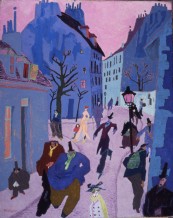The Colorful World of Lyonel Feininger
However, not all was fun and games during Feininger’s life. In the 1930s, the Nazi Party rose to power and Feininger found his work ridiculed and taken off the walls of museums. He had to prove that he was Aryan to be allowed to continue painting. His work during WWII, with its loose brushwork and absence of geometry, reflects the instability of the times. Yet, politics never made their way into his work; his art has always been more of an antidote to everyday life. The final straw came in 1937, when hundreds of his works were displayed in the Degenerate Art Show (entartete Kunst), as part of Nazi Germany’s campaign against modern art. Feininger left Germany and took up a teaching job in Oakland, California, then moved back to New York City.
Haskell explains, “[He] came home to a New York totally different from the one he knew as a child. He arrived without being known, with two dollars in his pocket…and had to start all over again.”
I ask her what distinguishes Feininger from other Bauhaus artists.
“[His] work is very spiritual, all about the alter-oscillation between whimsical compositions and somber compositions. [He found] beauty and order in the world, like a secular divinity. You feel it in the pictures, the sense of light in these canvases that suggests if not divinity, then at least that sense of connection we sometimes have with something beyond ourselves…it often happens in nature where everything else gets pushed aside except our period of connection with the universe.”
Indeed, I witness this most strongly in Feininger’s work from when he taught at the Bauhaus School. His paintings, especially those of the Baltic Sea villages, embrace a romantic sensibility that is delivered in a geometric vocabulary: layers of color using stipple technique that creates a picture so luminous that it feels like looking through layers of air and light.
Out of curiosity, I ask Ms. Haskell to tell me a bit about how these works were selected and collected for the museum. She chuckles and sums it up as a “long and arduous process,” in which she and other curators pick out his best works and piece them together to tell a story that shows two sides of his art existing side by side, allowing the Whitney to present “the fullest range of Feininger’s work that has ever been assembled.” And through this exhibition of Feininger’s works, the Whitney reclaims this renowned cross-cultural American artist for the first time in 45 years.
Lyonel Feininger: At the Edge of the World can be viewed at the Whitney Museum of American Art in New York City until October 16, 2011.


